Maybe rather strange to start a blog about product ownership, product management and agile with a post about keyboards, but this was the topic I was in to at the time and actually it is about productivity.
When going out to buy something new I’m the kind of person that goes many miles to find the best thing suitable for the best price. Sometimes maybe too far. Wow, I fell in to a deep rabbit hole and nerded out. During this journey I gained some knowledge to share, but I’m far from an expert. There is a lot more about keyboards and this article is more like a basic introduction to the topic. Many aspects I skipped and could be a material for another article.
Many of us use standard issue keyboard provided by our employers which are in many cases simple keyboards. I never had the funds for a real good keyboard, but now I sad to my self, that now is the time to invest some money to have good peripherals.
Feeling
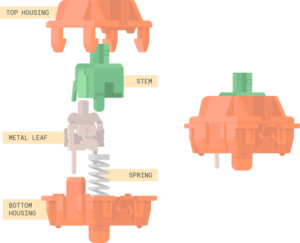
I was searching for something great for typing and something with dedicated multimedia keys as I listen to audio often. Soon it was clear that I will not buy a rubber-dome keyboard which are the most used and cheap keyboards. These are made of several layers of film with wiring printed on them and the switching of a key is done by squeezing down a rubber-dome that holds the key in the up position. The other type is called a mechanical switch. The switch doing the connection is from a plastic/steel mechanism. Nowdays they are more an more popular, not just because of the nostalgic feel of a clicking keyboard, but also they give a nice response and you can be more precise when typing. The key of on a mechanical keyboard is hold in the up position by a spring (some membrane keyboards also have springs) in the switch. It gives a perfect feeling and may give also a physical response to your finger depending on the type of the mechanical switch.
There are three basic types of switches: linear, tactile and clicky. They are also often referred based on color coding of a classical producer of the swithes, Cherry MX as – red, brown and blue. There are many other types of switches, different color codes and manufacturers, but the spectrum is from linear to clicky.
Clicky switches have an internal mechanism that is specifically added to make an audible click. You can feel the key press, but also you can hear it. This is not the best option for an open office, as it can be quite annoying and loud. As there are many manufacturers, some clickies are louder and some are almost like browns. Some people like a really specific sound of a click, but that’s for another article.
Brown switches are same as blue, but does not have the sound “effect”. They give a nice tactile response to your finger when the key is actuated, so you know by touch that the key was pressed. This tactile response is produced by a bump added to the sliding mechanism on purpose.
The least noisy and with no tactile response is the linear switch or a red switch. They are smooth as silk and give no resistance other then the spring and sliding of the mechanism. This is often used in gaming keyboard where fast responses are important.
All together the type of switch is a personal preference, but the most popular switch are the browns.
They switches can be soldered on the PCB or it can be press fitted to the PCB. If you want to experiment with different types of switches then you need this. You can buy any type of switches and swap them as you wish. Be careful with what number of stems for a switch the PCB supports.
Cheap keycaps are have think walls and are made from ABS (Acrylonitrile Butadiene Styrene). A better option is keycaps made from PBT (Polybutylene Terephthalate) as they are more durable and the legend of the keys are not wearing down as they are part of the material which they are made from. PBTs are not prone to “shine” out under our oily human fingers. Also the material feels different, more rough and not so slippery.
Sound
As already mentioned the clicky switches are producing a loud sound, but sound is produced also by the keyaps and the body of the keyboard. Low-end keyboards have empty shells and sound hollow. Thin keycaps are adding to this hollow sound. Longer keys as the space bar, shift or the zero button on number pad tend to produce a rattling sound. All of this contributes to the cheap sound of a keyboard. More premium keyboard have bodies from metal and they are filled out. To have better sound keyboard enthusiast are adding foam dampeners to soften the sound and produce a more pleasing sound. Overall as the feeling the sound is a very personal preference, but most of people don’t prefer loud and cheap sounding keyboards.
Visuals
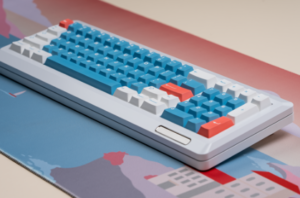
The biggest contributors to a look of a keyboard are the keycaps and the backlights. Basic visual is the legend of a keyboard it indicates what the key actually do. They are standardly printed (lasered, died,…) on the top of the key, but they can be printed also on the side (facing the user) or a key can be without any print at all. You should not look on the keyboard when typing, so why to have legends? 🙂 The color of the keycaps are also important for the looks. They are many color schemes, illustrations and more or less diverse.
Lightning can be just monochrome or the full spectrum of colors (RGB). For me to have lightning was important, so I can type in total darkness and the RGB is more of a esthetics factor. Although I have dedicated keys with different colors. You can assign different colors even for different programs. Thus RGB can be a contributor to productivity as you can highlight certain keys with different colors dedicated for different uses in different programs. This can be achieved also by changing the keycap to a different color (or form). But honestly I see RGB more as an esthetic gimmick (a very nice one).
Form
The most important question is what keyboard layout to choose and that’s a hard question. This is on personal preference and how you use your keyboard. The layouts are representing how much keys there are in comparison to a full size keyboard (100%) – 96%, 80%, 75%, 65%, 60% or some other sizes…(check sizes here). Very popular size is the so called TKLs (TenKeyLess), which is a standard full-size keyboard minus the number pad. Other sizes are rare.
What is also important is the keycap profiles. The most standard is the Cherry profile with a slight inclination toward the user. OEM and SA is more convex to the middle of the keyboard and XDAs are uniform keys. You should also take note that there is a difference between an ANSI and a ISO layout (there are also other layout but not so often):
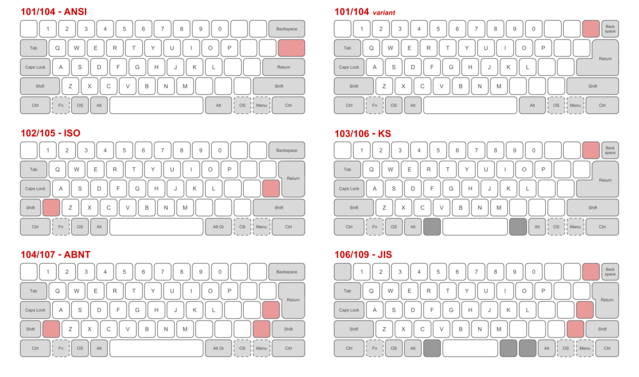
Keycap profiles:
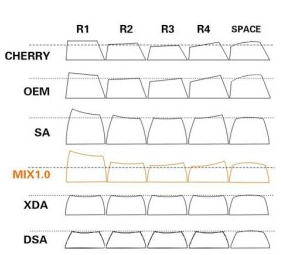
Basic size comparison:
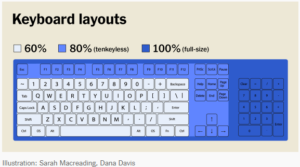
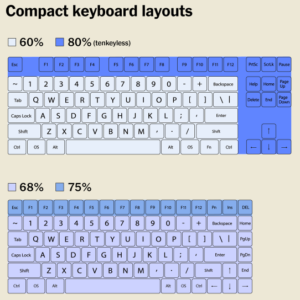
More about keyboard anatomy here
Connectivity and other
Many keyboards come also with some form of connectivity. If you need just a static keyboard that you don’t need to move around a wired keyboard would be sufficient. The cord then can be detachable (in case it breaks you can easily replace it) and usually connected via USB type C. Wireless keyboards then come with Bluetooth, Wireless 2.4 MHz connectivity or both, or other technology. Often wireless is preferred as Bluetooth connection tend to be more problematic for some devices, on the other hand you can connect to anything that has a Bluetooth.
What also is important is the battery when considering a wireless keyboard. The most capacity I’ve seen is 4000mAh. The Royal Kludge RK100 has a 3750mAh rechargeable battery and the specifics claim about 200 hours of having it on.
A great feature is when it has a USB ports. This is usable for adding a mouse or to have an additional macro board/number pad. Be aware that for some keyboards the ports are working just in case you are connected via a wire.
My take on the options
It’s really hard to say what would be the ideal keyboard for work, there are too many variables, that I have to test out. Layouts, profiles, switches etc… I started my testing with HyperX Alloy Elite 2 with red switches. I wanted to start with browns, but there were not available. The keyboards I was considering in my final decision for my first mechanical keyboard were: Rayzen Black Widow V3, Logitech G815 and Corsair K70 MK II. What convinced me at the end for Alloy Elite is the mechanical switch for changing RGB modes (which is not working when you have the keyboard app running), having a USB port at the back and the design. The race was pretty close as there is no much differences. All are pretty good. I decided to skip Logitech G815 as it had poor reviews complaining about broken LEDs and low quality keycaps.
After few days of testing of the Alloy Elite 2:
- I really like the volume roller (its from metal)
- I was not sure about the pudding keycaps, but I now like how they look, although they keycaps have no no texture (they are just ABS), so they are slippery and collects finger oil like crazy
- the build is great, it has a full metal plate under the caps and is brutally sturdy and heavy
- the dedicated media keys has a nice tactile feel to them
- it’s nice to have a dedicated key for brightness adjustment
- if it would be hot-swappable it would be absolutely perfect